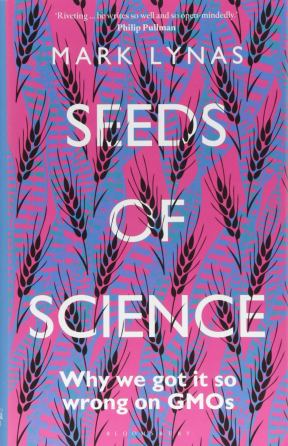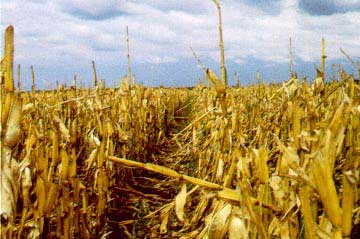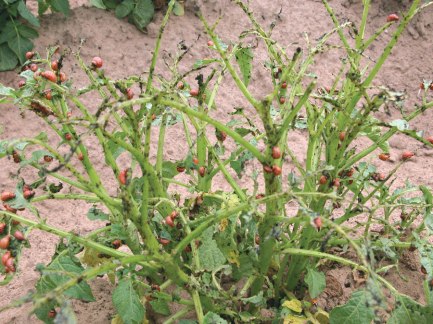
I confess I don’t read that many books in a year – preferring shorter Internet features instead – but I’m sure glad I found time in 2018 to read Mark Lynas’ Seeds of Science.
This excellent book is actually a collection of mini-books, including ones on the history of crop biotechnology, on NGO-led opposition to biotech development in Africa, and on the story of Monsanto. He dwells at length on Monsanto’s beginnings including much on its years as a chemical company before biotechnology – attention that I found especially interesting as it may help explain Lynas’ expressed personal aversion to all pesticides (a dislike that I believe goes beyond the science of pesticide regulation and safety – more here).
The book features an expansion of his view that opinions on many issues are based more on ‘tribal membership’ than rational analysis. This includes a description of his efforts to rebuild his relationship with former UK environmental clan members that was shattered when he came out in support of farm crop biotechnology. (Not much evidence that he converted many of them in the process.)
But the part of the book which affected me most was the initial chapter which I acknowledge – at least during first time reading – made me very angry.
The chapter describes how Mark Lynas, as a twenty-something-year-old, became indoctrinated by a Greenpeace campaigner on the evils of genetically engineered/modified crops – and then played an active role in destroying crop biotech plots, spreading anti-GM fears, and otherwise undermining public confidence in Britain in technology that offers so much potential for human well-being.
That chapter reopened some very unpleasant personal history for me – even if the outcome of that history in Canada was far more positive than what Lynas describes for the United Kingdom.
Why Farmers and the Environment Love Bt Corn
While Mark Lynas was ripping out crop biotech trials in the UK, I was the executive vice-president (chief of staff) of the Ontario Corn Producers’ Association (OCPA) and also farming near Guelph. Corn farmers had watched as corn breeders, both public and private, devoted major resources – both money and time – to a search for improved genetic resistance to the European Corn Borer (ECB) using conventional breeding techniques. It was largely a futile effort because meaningful genetic resistance to this insect did not exist in Zea mays; the breeders were effectively segregating lines into ones that were susceptible to borer larvae versus those that were highly susceptible.
A typical farm cornfield during most of the 20st century in Ontario had many broken plants at harvest time caused by borer damage. It was worse if high winds prevailed. I personally spent many hours removing broken plants that plugged the header of my farm corn picker. Several farmers I knew had their arms ripped off when they carelessly placed a hand in the wrong place of a running machine during this process. After 25 years of ‘picking’ borer-damaged corn, I am lucky that both of my arms are still attached!

Broken corn stalks caused by European Corn Borer
Corn borer damage triggered strong interest in large-scale insecticide application for borer control – as had already happening in France and then in Quebec and parts of the US Midwest. It was inevitable that it would happen in Ontario too, to the detriment of both farmers and the environment.
Then in the early 1990s we learned how biotech Bt technology – the transgenic transfer of a single gene from a bacteria used in organic agriculture into corn – could provide near total control. OCPA lobbied aggressively for Canadian approval. During late 1994 and 1995 scarcely a fortnight went by without a strong pitch to regulators in Ottawa to get Bt corn approved. We argued repeatedly that approval should come at the same time in Canada as the United States – to ensure competitiveness. (We came close: Canadian approval came within a week of approval in the US.)
It’s worth noting that our industry contact and the applicant for Bt approval in Canada was not Monsanto but, rather, the Swiss-based company, Ciba-Geigy (later, part of Syngenta). Monsanto was essentially a chemical and fledgling biotech company at the time, but with almost no profile presence in commercial corn breeding. (Its many purchases of plant breeding companies came later.)
Bt corn was an instant success in Ontario and the acreage of planted Bt corn grew rapidly beginning in 1996. The sight of entire cornfields with scarcely a fallen plant at harvest time was something new. Farmers upped their seeding rates (seeds per acre), yields increased, and still the plants did not fall over because of weakened stalks caused by borer injury.
None of us at that time – regulators or corn farmers – detected serious opposition from mainstream environmental NGOs. Indeed, we assumed they’d be delighted with new organic-based technology which all-but-eliminated need for post-planting synthetic insecticides.
Greenpeace Canada Gets Involved
I don’t remember specifics but I believe that it was in 1997 when we in OCPA became aware of fledgling NGO opposition to biotech-enhanced crops. It came to Canada from Europe and, to a lesser degree, the United States. Initially it involved individuals and local groups generally opposed to everything in modern field crop agriculture. But then Greenpeace Canada picked this as a priority issue and the game changed.
OCPA’s relationship with Greenpeace had actually been somewhat congenial up until that time. Greenpeace reps had visited us in Guelph a few years earlier to learn more about corn-based fuel ethanol and had offered to help in promotion. I recall a common news conference in Toronto.
(Greenpeace reps said that though they were not wildly enthusiastic about making fuel from grain corn, it was better than from petroleum, and a step to ethanol manufacture from cellulosic sources. OCPA was OK with that. Our corn plants contained cellulose too.)

At first, the Greenpeace opposition was tepid – after all corn growers and Greenpeace were allies on fuel ethanol – but it accelerated rapidly and our fuel ethanol-based friendship disintegrated. I recall asking a Greenpeace contact at the time why the organization could not separate technology (transgenic modification) from company (Monsanto). For in truth, while corn growers loved Bt technology, we were also displeased with the way in which Monsanto was then buying plant breeding companies everywhere.
The Greenpeace person was very frank: Greenpeace Canada got marching orders from head office in Amsterdam and the latter wanted issues to be simple. Simple meant that the ‘big arrogant American chemical company was trying to dominate world agriculture using biotech.’ Monsanto was bad and, hence, biotech was bad. No room for subtleties.
My contact left Greenpeace soon afterwards and that’s the last friendly conversation I ever had with that organization.
Ontario Farm Groups Attack Greenpeace
Initially, OCPA and other Ontario farm groups assumed that Monsanto and other biotech companies (or at least their Canadian offices) would be able to counter the Greenpeace campaign but we quickly realized that this was not going to work. Greenpeace was far more effective than corporate communications staff, even when coached by high-budget PR firms.
So the farm groups took a different approach, organizing a collective effort which included OCPA , the Ontario Soybean Growers (keen to defend their usage of Roundup-Ready soybeans), AGCare (a coalition of Ontario crop farm groups created initially to address pesticide issues), Ontario Agri-Food Technologies (a coalition to advance new agri-food technology) and Dr. Doug Powell, then head of a very skilled food safety and communication group at the Ontario Agricultural College, University of Guelph. The approach included a flood of media releases and media interviews, large numbers of speaking engagements, and many personalized explanations about why family farmers and the environment loved the new biotech crops.
It also included direct attacks on Greenpeace.
The pitch against Greenpeace was simple – a huge multinational bully trying to squash small farmers trying to make a better world. Somewhere we discovered two nearly-identically worded news releases from Greenpeace condemning crop biotechnology, one from Amsterdam and one from Canada. The only difference was in the names of the quoted spokespersons (European versus Canadian). This served us well, too: Greenpeace Canada was simply a puppet of a multinational based overseas.
It got very personal. I recall a day of angry emails with a continual stream of copies going back and forth between me and other farmers, and the Greenpeace biotech campaigner located in Montreal. (This was just before the era of social media; now we would have used Twitter and Facebook.)
Greenpeacers were good at their job. They attempted to portray the farmers and farm groups as dupes of the chemical-biotech companies, but farm groups had been careful not to take money from the latter, and the GP message didn’t work that well. Greenpeace did not know how to respond when it was the one being portrayed as a multinational heavy attacking small farmers.
In truth, lack of operating money was not a major impediment since most of our operations weren’t expensive. But they did take a lot of time. More than a third of my time as executive VP was spent on this battle. Dr. Gord Surgeoner, president of Ontario Agri-Food Technologies at the time, devoted even more. Gord was a highly effective speaker, complementing Doug Powell’s media skills, and we had a lineup of media-trained, articulate farmers ever ready to be interviewed by anyone on a moment’s notice.
What we were doing was recognized outside Ontario and Canada. Representatives of both the National Corn Growers Association in the United States and the Association générale des producteurs de maїs in France came to visit to learn about our approach. A leader of a canola industry council from Western Canada stopped in to tell us that we as farmers were making a big mistake and would get burned for challenging Greenpeace; we ignored him. One major disappointment was the failure of potato producers in Atlantic Canada to support our efforts in favour of Bt potatoes – for we also grew some Bt potatoes in Ontario and were well aware of the benefits in reducing pesticide usage.
(When Bt potatoes were first marketed in Atlantic Canada, they initially enjoyed a market-price premium because of reduced pesticide usage. That all changed through a combination of Greenpeace-type pressure and lack of action by local producer groups. Bt potato production ceased and Atlantic potato growers have been hounded ever since for their heavy usage of insecticides.)

Injury caused by Colorado Potato Beetle which can be controlled by Bt technology or pesticide applications
Perhaps even sadder was the way in which the Canadian wheat industry opposed biotechnology that offered such promise for that crop too. The Canadian Wheat Board (CWB) (government run but with some producer-elected board members) actually staged a joint news conference with Greenpeace in Winnipeg, repeating some of the latter’s lies about the safety of biotech-enhanced crops.
I personally stopped growing wheat a few years ago, having grown weary of near-static yields and the several pesticide applications needed to ensure success. Perhaps acceptance of biotechnology in the wheat industry might have made a difference.
Greenpeace Canada Ends Campaign
The Greenpeace campaign in Canada ended very abruptly in about 2001 or 2002 – I don’t recall the exact date – when their GM campaigner suddenly quit and left Greenpeace. He was not replaced.
Perhaps we played a role – his resignation came shortly after a particularly heated email exchange with farmers – or perhaps not. Sixteen or 17 years later, that position has not been refilled and Greenpeace Canada is not active today in anti-GM campaigning.
This all happened more than a decade and a half ago and the world moves on. Anti-GM crop activism is alive again – or perhaps still – in Canada, though not nearly with the same high intensity as existed at the beginning of this century. (Tides Canada has an anti-GM program, possibly funded in part using funds from the parent Tides organization in San Francisco. However, its efforts are quite low-keyed compared to former efforts by Greenpeace Canada.)
I thought I’d also moved on personally – at least until reading that initial chapter of Seeds of Science when it all came back.
I’m still angry at efforts by multinational Greenpeace to destroy technology that has proven so beneficial in limiting pesticide usage – and still 100% effective in protecting Canadian cornfields from European corn borer infection.
As a postscript, insecticide spraying has again returned to some Ontario corn fields, not for control of ECB but rather Western Bean Cutworm, an insect which aids in the infection of corn kernels with mycotoxin-causing fungal disease. The race is on to develop alternative biotech control. But at least this time, Greenpeace Canada is unlikely to be a notable opponent.
1 Comment